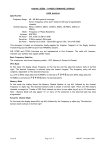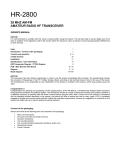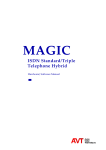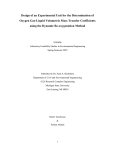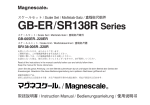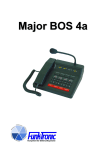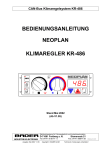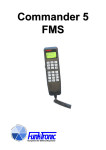Download Major 6a
Transcript
Major 6a Content Page Content General Features Display Elements Major 6a Control Elements Major 6a Rear view Major 6a Sockets pin layout Major 6a RS232 Connecting cable for flashing/printing/monitoring Settings RS232 interface Keyboard layout in the programming mode Major 6a Reset EEPROM-addresses EEPROM-addresses (continued) EEPROM-addresses (continued) EEPROM-addresses (continued) EEPROM-addresses (continued) EEPROM-addresses (continued) EEPROM-addresses (continued) -2Kompetent für Elektroniksysteme 2 3 4 4 6 6 7 7 22 23 27 28 29 30 31 32 33 m6a-eng (18.12.2009) General Features The Major 6a is the newer design of the well-known Major 6. The display is an alphanumeric LC display with background lighting. A gooseneck microphone with high dynamics is standard. All keys can be programmed freely. Two different functions can be assigned to each key. Up to 4 radios can be connected and used simultaneously by using a multi-core cable (7 cores) for each radio. There is a squelch input, a PTT output, a potential-free AF input and a potential-free AF output for each radio. A headset and a voice recorder (all 4 radio channels merged on one output) can also be connected. Futhermore there are 3 switching outputs (alarm switching output, recorder control and headset switching) and a serial interface (RS232 or optional RS485) . For the exact pinout see section Sockets pin layout connections. The Major 6a can be programmed by using the keyboard. For displaying a protocol a printer or a terminal can be connected to the serial port.The serial port can also be used for service or special applications. The Major 6a is automatically turned on if connected to power supply. After turning it on <Funk Tronic Major 6a> is displayed for a second , then the device is ready for operation. Hint : At initial operation the Major has to be leveled to the radio system ! After turning on the following display appears on the Major 6a Funk Tronic Major 6a È after 2 seconds no radio circuit active m6a-eng (18.12.2009) -3Kompetent für Elektroniksysteme Control Elements Major 6a gooseneck microphone Status-LEDs Handset with PTT button LC-Display Channel buttons Special buttons PTT button Short dial button Call button Loudspeaker button Display Elements Major 6a LC-Display All alphanumeric displays are shown on a LC-display with background lighting (2 lines with 24 characters) . The display lighting can be configured in the EEPROM-register 009. For programming the EEPROMs please read the section Programming mode EEPROM-addresses. The display lighting is turned on ex factory. Busy LED The busy LEDs (channels 1..4) are programmed in the EEPROM-register 095 at the digits 1.-4. To control the busy LED any DC voltage between 0V and 1,25V or between 3,75V and 12V can be used. The operating mode can be configured as follows: Register 095 1. - 4. digits busy LED 2 = with squelch input < 1,25V (LOW) 4 = with squelch input > 3,75V (HIGH) -4Kompetent für Elektroniksysteme m6a-eng (18.12.2009) TX LED For each of the four channels there also is a separate TX LED , which lights up when the corresponding transmitter is activated. The transmitter is activated by pushing a PTT button while talking or transmitting a call. Flashing of the TX LED means that another Major 6a is already using this channel (PTTT output on LOW < 3V). Loudspeaker LED / Call detection LED The loudspeaker LED (channel 1..4) lights up when the loudspeaker of the corresponding channel is activated on operating volume. A flashing loudspeaker LED means that a call has been detected (call detection LED). The call detection LED disappears when the corresponding channel is actively used for transmitting, or when the channel is activated (register 001/2). F-Buttons (channel buttons) LED The function of the F-buttons LEDs is programmed in register 001 at the 1st digit. The LEDs (LEDs in the selection buttons) flash when there is at least one identified call saved in the identification memory of the corresponding channel. The corresponding LED disappears only after all identifications have been deleted in the corresponding identification memory. Also see section Identification Memory - (register 001/1 = 2). The LED is turned on if the corresponding channel is activated - (register 001/1 = 1) The LEDs are always turned off - (register 001/1 = 0) Ex factory programming of the buttons This specification is valid for the ex factory programming of the buttons. As all buttons can be programmed freely the functions of the buttons of individually programmed Major 6a can differ from this description. Button F1...F4 0...9 S1...S3 S4 * # PTT CALL Z Loudspeaker m6a-eng (18.12.2009) Function short Function long channel 1...4 on/off call signal button 0... none last channels on/off call signal button A displaying the next identification transmitting with gooseneck micro transmit selected call as 5-tone sequence select short dial and transmit as 5-tone sequence turn off loudspeaker volume control channel 1...4 none none adjust headset volume channel selection deleting of the current identification none transmit return call as 5-tone sequence none adjust total volume -5Kompetent für Elektroniksysteme Rear view Major 6a PWR ST15 ST14 ST12 ST13 ST4 ST3 ST2 ST1 Sockets pin layout Major 6a All sockets of the Major shown from rear view. Layout TB (audio tape) ST14 Layout FK 1- 4 (radio channels) ST1 - 4 RX-AF-input (earphone +) RX-AF-input (earphone -) squelch-input (carrier) GND (ground) output +12V, max. 200mA PTT active low TX-AF-output (Mod +) TX-AF-output (Mod -) GND (ground) audio tape switching contact AF-output (Mod. +) AF-output (Mod. -) 1 2 3 4 5 6 7 8 2 There are two sockets for a headset. The headset is connected to ST13 and an external PTT-button (e.g. a foot switch) can be connected to ST12 or ST13. Attention: 200mA are not sufficient for a radio. Layout HS (Headset) ST13 Layout Power PWR PTT input (PTT2, to GND) AF-input (Micro +) AF-output (earphone +) GND AF-output (earphone -) GND AF-input (Micro -) GND (PTT2-GND) 12 VDC, max 1,5 A, center positive pole, ring ground (GND) Layout RS 232 ST15 input 1 Sw, output TxD RxD GND input 2 1 2 3 4 5 6 Layout PTT (headset switching) ST12 1 2 3 4 5 6 PTT input (PTT2, to GND) +battery-out., supply voltage for headset switching PCB control output for headset switching PCB optocoupler input(anode +) optocoupler input(cathode -) GND (PTT2-GND) For protocolling a printer can be connected to the RS232. -6Kompetent für Elektroniksysteme 3 4 The AF-output is equipped with a transformer and therefore is potential-free. The AF- in/outputs are equipped with transformers and therefore are potential-free. An external device (FT630-2, FT6304aC) can be powered with contact 5 (+12V) . The serial interface can be laid out as RS485 (option)! 1 1 2 3 4 5 6 m6a-eng (18.12.2009) RS232 Connecting cable for flashing/printing/monitoring RS232 connector at the Major RS232 9-pole plug at the computer Pinout RS232 ST15 2 RxD RS232 3 TxD RS232 5 GND TxD RxD GND 1 2 3 4 5 6 Settings RS232 interface 9600 Baud, 8 databits, no parity, 1 Stopbit, no protocol m6a-eng (18.12.2009) -7Kompetent für Elektroniksysteme Calling a radio subscriber Channel selection To activate one of the four channels push the corresponding selection button F1 to F4. To deactivate a channel again push the same or a different selection button. You can also select several channels simultaneously by keeping the first selected channel button(s) pushed down while additionally selecting more channels. When channels are activated the corresponding loudspeaker LED lights up. Example: C h a n n e l 1 + 2 Call: _ Communicating with the calling radio subscriber There are three different ways of communicating with a calling radio subscriber: a) By pushing the red PTT button the transmitter of the selected channel is turned on (the corresponding sending status LED lights up) and you can talk to the caller through the gooseneck microphone. After depressing the PTT button the caller can be heard on the loudspeaker in regular operating voulme. The volume of the loudspeaker is adjustable. See section Switching of the loudspeaker status and Regular operating volume. b) Or by picking up the handset and pressing the PTT button on the inside of the handset. By doing this the trasmitter of the selected channel is activated (TX LED lights up) and you can talk with the caller through the microphone of the handset. You can hear the caller on the handset. The call is ended by replacing the handset. The volume of the earphone and the microphone level are each adjustable with a potentiometer. The potentiometer is situated near the earpiece of the handset and is easily accessible from the outside by using a screw-driver through a small opening on the inside of the handset. c) Or by connecting a compatible headset and pressing the corresponding PTT button (e.g. a foot switch), which has to be connected to the PTT input (connector ST12/ST13). By doing this the transmitter of the selected radio channel is also turned on (TX LED lights up) and you can talk with the caller through the microphone of the headset. You hear the caller on the earphone of the headset. The volume can be adjusted with the button S4 (long). The microphone sensitivity can be adjusted separately for all 3 microphones in the setup menu „level adjustment“. -8Kompetent für Elektroniksysteme m6a-eng (18.12.2009) !!) If a PTT button is pushed without having selected a channel, there are two possible reactions of the Major 6a, depending on the programming of the 3rd digit in the EEPROM-register 001 (0 = latest selected channel; 1 = signal tone) : a) the latest selected channel is activated automatically. After turning on the radio installation no channel is activated, so that in this case channel 1 is activated automatically, or b) a signal tone on the loudspeaker draws the user´s attention to the operating error. After ending the call the activated radio channels can be deactivated by pressing the corresponding selection buttons again or by pushing button S4. Switching of the loudspeaker status By selecting a radio channel the loudspeaker is switched to the activated channel in regular operating volume. See section Regular operating volume. If no channel is activated the loudspeaker can be switched to the latest activated channel(s) in regular operating volume by pressing button S4. After that the loudspeaker can switched back to listening volume by pressing the corresponding selection buttons or button S4. See section Listening-in-volume . After detecting a call the loudspeaker is automatically switched to the corresponding channel for an adjustable period of time in the calling volume - unless the channel has already been activated. See section Calling volume. The loudspeaker can be muted by shortly pressing the loudspeaker button. If the receiver is lifted the loudspeaker is automatically muted. By putting down the receiver the loudspeaker is automatically turned on again. The possibilty of interconnecting the regular operating or the listening volume to the earphones, the loudspeaker (and/or the recorder output ) is configurated in the EEPROM-register 000. Register 000 Configuration for AF interconnections 1st digit RX-AF on receiver / headset 2nd digit RX-AF on recorder output 3rd.digit on loudspeaker, when receiver is put down 4th digit on loudspeaker, when receiver is lifted 5th digit allows RX-AF on loudspeaker during PTT valid for all digits: 0 = no AF 1 = AF of activated channels 2 = listening in-AF of deactivated channels 3 = AF of acitvated channels and listening in-AF m6a-eng (18.12.2009) -9Kompetent für Elektroniksysteme Regular operating volume To change the regular operating volume first press down the loudspeaker button for a longer time. The display now shows <Total volume> and next to this on the right side the prompt flashes. The volume can be set between '0' and '9' . The set volume is saved even after turning off. But a set power-on-volume can be programmed in register 090/1+2. Listen-in-volume If a radio channel is not activated,you can „listen in“ on it with the listen-in-volume. To change the listen-in-volume (channel x) keep the corresponding selection button F1 to F4 pressed for a moment. The display now shows <listen-in channel x : > and the prompt flashes. The volume can be selected between '0' (listen-in=OFF) and '9' (listen-in-volume=operating volume) . The set volume is saved even after turning off. But a set listen-in-volume can be programmed in register 091/1-5. Call volume If a channel is not activated the loudspeaker is switched to this channel in call volume for an adjustable length of time after detection of a call. Then the loudspeaker returns to its previous status . The length of time can be encoded for each of the ten decoders in steps of seconds (0..F = 0..15) in the EEPROM-registers x30 - x39 at the 4th digit. The call volume of the 10 decoders (channel 1..4) can be programmed between '0' (call volume = OFF) and '9' (call volume = operating volume) in the above mentioned EEPROM-registers at the 5th digit. An adjustable volume can be selected with A - F. „A“ meaning the latest set volume , B (+1) to F (+5) a volume increased by 1 - 5 levels. Recording of a call It is possible to record calls with the built in recorder/monitoring interface. The interface has a potential-free AF-output and a switching contact to ground for controlling the recorder. The switching contact switches according to the conditions programmed in register 002 at the 4th and 5th digit if: a) a squelch can be detected on a channel or lights up) and a squelch can be b) at least one channel is activated (channel selection LED detected on this channel (busy status LED lights up) and/or c) the channel is used for transmitting (TX LED lights up). After discontinuation of these criteria the contact is turned off with an adjustable delay time . This delay time is programmed in steps of seconds in the EEPROM-register 002 at the 1st - 3rd digit. - 10 Kompetent für Elektroniksysteme m6a-eng (18.12.2009) Major 6a‘s in parallel circuit Several Major 6a´s can be interconnected without any problems as the AF-outputs are only activated during transmitting and the AF-inputs can be switched to high-impedance by disconnecting jumpers JMP1 / 1 - 4 (see section Layout) . For this purpose all connections with the individual radio channels (TX-AF, RX-AF, squelch and transmitter PTT) only have to be connected in parallel circuit (bus- or hub wiring). Telephone AF-connection The audio-frequency-connection is not integrated in the Major 6a anymore. But by connecting the external headset-adapter the headset can be used as a combined communicating device for telephone and radio. The headset is switched to the telephone by an opto-coupler input, which has to be programmed accordingly (see section Opto-coupler input). Transmitting of calls To transmit a call at least one channel has to be activated. If no channel has been selected manually a signal tone on the loudspeaker draws the user´s attention to the operating error. Calling by selective call First at least on channel has to be selected with a selective call. Then the calling code is entered by using the numerical keys 1 ... 9. The entry is complete when no prompt flashes anymore. The call is transmitted with the call button and can be repeated with it. Calling by short dial The Major 6a has 10 codeable short dials per channel. The corresponding short dial for an activated channel is transmitted by shortly pressing the button Z and then entering a number from '0'...’9' . The short dials (channel 1..4) are programmed in the EEPROM-registers x00 - x09. Calling by group call To be able to use the calling system without any restrictions, the special tone 'A' should be used as a group call signal. This special tone 'A' is entered with the button * . The group call tone can be entered at any position. By pressing the call button the call is started and can also be repeated by using this button. m6a-eng (18.12.2009) - 11 Kompetent für Elektroniksysteme Calling by collective call /single tone call It is possible to preselect 9 collective call frequencies (0..8) per channel . The frequency codes of these single tones are calculated according to this formula 1.008.000 X = -----------------F [Hz] and are coded in the UGA(1..4)-registers 000...008 as four digit hex-numbers. Please read the sections Programming mode UGA and Attachment, Conversion table (...). Example: collective call 1 (channel 2) has the frequency 2135 Hz, then this results in: 1.008.000 X = ------------------ = 472,13 2135 ==> hex-value = $01D8 therefore UGA(2)-reg. 001 = 01D8. The corresponding collective call signal (single tone) of the activated channel is transmitted by pressing a collective call button which has been programmed accordingly. The number and the duration of the collective call signal 0...8 which is to be transmitted is defined when programming the button. Ex factory there is no button programmed for collective call . Status input By pressing a status input button programmed for this purpose you get to the status input of the activated channels. Also see section Transmit call with status. Now you can enter a status with up to three digits by using the numerical keys 0...9 or you can use the button * to delete a previously entered status. The input is complete when no prompt flashes anymore. After that the display returns to the standard display. Ex factory there is no button programmed for status input. Return call If you keep the call button pressed down for a moment the ID (received call) which is currently shown on the display is transmitted as a call. Also see section Identification memory. The return call channel can be adjusted in register 001/5. - 12 Kompetent für Elektroniksysteme m6a-eng (18.12.2009) Signaling when pressing or depressing the PTT button The signaling has to be defined in the function of the buttons or the inputs (reg. 010-089). No signalings have been activated ex factory. Every time when starting and/or ending using a PTT button the own ID (from/in EEPROMregister x15) and/or a „Roger-Peep“-tone (from/in EEPROM-register x53) can be transmitted automatically. An individual „Roger-Peep“-tone can be preselected for each channel. The frequency code of this single tone is calculated according to the following formula 1.008.000 X = -----------------F [Hz] and is coded as a 4-digit hex-number in one of the UGA(1..4) - registers 000-008. Please also read the sections Programming-mode UGA and Attachment, Conversion table (...). Example: Roger-Peep tone 0 (channel 3) shall have the frequency 2000 Hz, therefore: 1.008.000 X = ------------------ = 504,00 2000 ==> hex-value = $01F8 therefore UGA(3)-reg. 000 = 01F8. The duration and the relating single-tone register in the UGA is programmed in register x53. m6a-eng (18.12.2009) - 13 Kompetent für Elektroniksysteme Configuration of the tone sequence encoder Preadjustment of fixed tones It makes sense to program the digits of the tone sequence, which shall not be entered with the keyboard. These tones can be set at any position of the tone sequence. Therefore it is possible to fix the 1st, 3rd and 5th position. In this case the 2nd and 4th position is entered by using the keyboard. If there is a sequence of identical tones the repeat tone is automatically inserted at the correct position. The encoders (channel 1..4) are coded in the EEPROM-registers x10. Also see section Programming mode EEPROM. The prefixed tones can always be displayed with the call input, so that different quantities of variable digitis can be coded for the encoders. If there are several channels activated at the same time the prefixed tones of the lowest-order channel are used automatically. The quantity of the displayed tones is programmed in the registers x55 at the 4th digit. To turn off the tone sequence encoder use the programming EEEEE. Transmitting a call with ID IDs (channel 1..4) are coded in the EEPROM-registers x15 . (Normally the ID has the same code as the encoder 1, but if necessary a different code can be chosen.) Depending on the configuration the ID is automatically transmitted before or after each call or short dial, and either a connecting tone or a rest with adjustable duration is inserted between the two tone sequences of a double sequence. The duration is coded in steps of 5ms in the corresponding UGA(1..4)-register 243 at the 1st+2nd digit (hex-value !) . The connecting tone resp. the rest (0..E = tone 0..E; F = rest) is coded at the 5th digit for the button and enter functions - function 2 (transmit call). If the ID mode is used with 6-, 7- or 8-tone sequences, the last 1 -3 digits of the ID are attached to the call number. Transmitting a call with status The status selection is configurated in the EEPROM-register 005 at the 1st digit . If no status selection is necessary please code this position with '0'. The status can be configurated with up to three digits and is attached to the end of each 5-, 6-, 7- or 8-tone sequence (not for double sequences !), and the length is increased by up to three digits. If the ID mode is used with 6-, 7or 8-tone sequences, an 8-tone sequence for example is turned into a 10-tone sequence when there is a 2-digit status selection. For information on status input see section Transmitting calls. register 060 1st digit 0 = no status selection 1...3 = number of digits for status selection - 14 Kompetent für Elektroniksysteme m6a-eng (18.12.2009) Receiving calls The Major 6a can identify up to 10 different decoder programmings per channel. The IDs of the 10 decoders (channel 1..4) are coded in the EEPROM-registers x20-x29 . Decoders which are not needed have to be coded at the 1st + 2nd digit with 'E' or at the 8th digit with '0'. The configuration can be adjusted separately for each decoder of the 4 channels in the EEPROMregisters x30-x49. The following features can be configured: - call tone - call volume - ID-mode - alarm switching output and its activation time - acknowledgement mode For simplicity the following information always refers to decoder1 of channel1, the configuration of which is programmed in the EEPROM-registers 130+140 . All other decoders (if needed) are programmed in the same manner. Decoder (1) The decoder1 of channel1 is coded in the EEPROM-register 120 at the digits 1-7. Please also read section Programming mode EEPROM. Variable tones and tones which are not used, have to be programmed with 'F'. Each received tone sequence is compared with the programming of the decoder, and every tone of the tone sequence at the positions coded with an 'F' is accepted. The decoder can be activated or deactivated at the 8th digit in register 120. After the correct identification of the tone telegram the ID (if available) is saved (if configured), the configured acknowledgement is transmitted, the loudspeaker is activated with the call volume (if the channel has not already been activated) and the configured call tone is started. If double sequences are used the acknowledgement is delayed by 1 second max. . Also see Identification memory. There is no additional check of the tone sequence by decoders with higher indices. Principally decoder1 has the highest priority and decoder 10 the lowest when decoding a telegram. Call tone The sound of the call tone can be configured separately for each decoder of each channel in the EEPROM-registers x30-x39 at the 1st digit. You can choose between 10 different types of call tones '1'...'9' and 'A' . The types 1-5 can be repeated up to 9 times. For this the 1st digit has to be programmed with 'B' (type 1) ... 'F' (type 5). If you don´t want a call tone program '0' at this digit. The duration of the call tone can be programmed in the above mentioned EEPROM-registers at the 2nd digit in steps of 200ms (0,2...3 sec / 0=infinite) and the volume of the call tone can be programmed at the 3rd digit(0..9, A...F). 0 - 9 = set volume A = actual volume B - F = actual volume + 1(B) - 5(F) steps m6a-eng (18.12.2009) - 15 Kompetent für Elektroniksysteme ID-mode The ID-mode for each decoder can be coded separately in the EEPROM-registers x40-x49 at the 1st digit. (Also see EEPROM-addresses) register x40 - x49 1st digit 2nd digit 3rd digit 4th digit 5th digit 6th digit ID-mode 0 = 5 tone sequence 1 = call, ID (double sequence) (3-7 tone sequence) 2 = ID, call (double sequence) (3-7 tone sequence) 3 = 6 tone sequence 4 = 7 tone sequence 5 = 8 tone sequence 6 = 3-7 tone sequence without ID 7 = 5 tone sequence without ID 8 = 4 tone sequence 9 = 3-7 tone sequence A = emergency call 5 tone sequence B = emergency call 5 tone sequence ZVEI D = emergency call 2 x 5 tone sequence (forest emergency call) The tone duration of the 3-7 tone sequences is programmed in register x55 at the 4th digit. switching output 0 = none 1 = switching output ST 15/2 2 = tape switching output ST 14/2 3 = headset switching output ST 12/3 switching output (0 = off, F = on, 1 - D = 1 - 13s activation time) acknowledgement 0 = none 1 = acknowledgement 3 = own ID 4 = received ID loudspeaker / activate LED (0 = no, 1 = loudspeaker, 2 = LED, 3 = loudspeaker + LED) emergency call flag for 3-7 tone sequences (only for ID-Mode: 1, 2, 9) 0 = regular call - no emergency call 1-7 = emergency call, display 1 - 7 digits from the right Between the two tone sequences of a double sequence either a connectiong tone B or a rest can be inserted. The rest can be omitted. If so the two tone sequences are transmitted directly one after the other (instead of a 2x 5 tone sequence, it is then a 1x 10 tone sequence). Alarm switching output The Major 6a has 3 possible alarm switching outputs. But the switching outputs 2 and 3 also have other functions which then cannot be used. After the identification of a correct tone sequence by a decoder the chosen switching output (see above mentioned 2nd digit) is activated for N seconds. The acitivation time N can be configured for each decoder (channel 1..4) separately in steps of seconds in the EEPROM-registers x40 - x49 at the 3rd digit.(see above). - 16 Kompetent für Elektroniksysteme m6a-eng (18.12.2009) Acknowledgement After the correct identification of a tone sequence by a decoder either no acknowledgement, a standard acknowledgement, the own ID or the received ID is transmitted, depending on the configuration. The standard acknowledgements (channel 1..4) are programmed in the EEPROM-registers x17 and the own IDs are coded in the EEPROM-registers x15. The acknowledgement mode can be coded for each decoder separately in the EEPROM-registers x40-x49 at the 4th digit: register x40 - x49 4th digit 0 1 3 4 Acknowledgement mode decoder = no acknowledgement = standard acknowledgement = own ID = received ID Group call decoder A group call decoder for tone A (or 0) can be implemented with every decoder by coding the group call signal A (or 0) at the desired digit in the tone sequence of the corresponding decoder. As no acknowledgment can be transmitted, the 4th digit in the corresponding configuration register 2 has to be coded with '0'. Also see sections Acknowledgement and Programming mode EEPROM. Example: A group call decoder is to be realized with decoder 3 (channel 2) for the sequence '1 2 1 0 A’ (group of 10). To do this the following registers have to be programmed as follows: register 222 register 242 =1210AFF1 =0xx0x000 Collective call decoder The collective call decoder (channel 1..4) decodes single tones of a certain length of time. This length of time can be defined in steps of 5ms in the UGA(1..4)-register 245 at the 1st + 2nd digit for special call signals and at the 3rd + 4th digit for tone sequence signals. After decoding the loudspeaker is turned on with call volume (if the channel has not yet been activated), the configured call tone is started and the programmed acknowledgement is transmitted. The group call decoder is programmed in the EEPROM-registers x84 and x85. The group call decoder can either decode a tone from a tone sequence or a special call signal. The tone which is to be decoded is programmed at the 1st digit (0-E for a tone of a sequence 0-E, 1 or 2 for call 1 or call 2). For decoding a tone of a tone sequence the 2nd digit has to be programmed with 0-3. For decoding a special call signal the 2nd digit has to be programmed with 8-B. m6a-eng (18.12.2009) - 17 Kompetent für Elektroniksysteme Identification memory In register 001 at the 4th digit you can program if a common identification memory (20 IDs) or 4 identification memories per channel (5 IDs each) is/are to be used. The identification memories can be adapted to the corresponding application. If all memory IDs are occupied, the memory is refreshed and the oldest ID is dropped. After selection of a channel the saved identifications can be scrolled by using the key # (press shortly). The displayed ID can be deleted from memory by using the key # (press long) or the ID can be transmitted as a return call by pressing the call button for a longer time. If the fifo-function is activated the oldest ID is displayed with the identification memory -button and only after deleting the next ID it moves up. The fifo-function is programmed in the EEPROMregisters x86 at the 2nd digit. (0 = OFF, 1 = ON). The identification memory can be used for all ID-modes with ID (0-5, 8, 9).? See section Receiving call, ID-mode. The ID digits for the ID-modes 3-5 are defined (5 tone sequence + 1-3 digit ID). For the other IDmodes the key tones are used for the identification memory. Key tones The key tones are coded in the EEPROM-registers x16. The coding of the key tones selects the IDs, which are saved, and determines which digits of the ID are shown on the display. The digits at which all tones are allowed and which are later shown on the display and all unused digits have to be coded with 'F'. Please also read section Programming mode EEPROM. Memory refresh If a new ID is received there is a checkup to see if the same ID already exists in the memory. If the ID has already been saved and the refresh function is not activated, the received ID is dropped. If the refresh function is activated the ID is deleted at the former position and is saved again at the first position. The identification memory is always arranged chronologically. The refresh function is programmed in the EEPROM-registers x86 at the 1st digit (0 = OFF, 1 = ON). Also see Programming mode EEPROM. Example: In the following example an identification memory is configured for channel 3, which saves every ID beginning with '1 2 1'. The identification memory is to be refreshed and the fifo-function is turned off: register 316 1st - 5th digit register 386 1st digit 2. digit value 121FFFFF 0 = refresh function OFF 1 = refresh function ON 0 = fifo-funcion OFF 1 = fifo-function ON value 1 0 IDs are only entered in the identification memory if they have been decoded by a decoder whose ID-mode has an ID. - 18 Kompetent für Elektroniksysteme m6a-eng (18.12.2009) Tone sequence parameter for encoder and decoder Tone duration (encoder) The duration of the 1st tone (channel 1..4) is defined in the UGA(1..4)-register 244 at the 1st and 2nd digit. The duration of the other tones (channel 1..4) is adjustable in the UGA(1..4)-register 244 at the 3rd and 4th digit. The values can be configured in steps of 5ms and are encoded to their exact specifications. Please refer to the section Tone chart for the programming of the different tone durations. The duration of the first tone may differ from the other tones. For example: tone duration 1st tone = 1000ms and 2nd to 5th tone = 70ms. Tone duration (decoder) Certain tolerances have to be allowed when decoding a tone sequence so that unexact tone telegrams can be decoded reliably. The minimal duration of each tone of a tone sequence (channel 1..4) is defined in the UGA(1..4)register 241 at the 1st and 2nd digit. The maximum duration of the 1st tone (channel 1..4) is adjusted in the UGA(1..4)-register 242 athe 1st and 2nd digit. The maximum duration of the other tones (channel 1..4) is adjustable in the UGA(1..4)-register 242 athe 3rd and 4th digit. The values are selectable in steps of 5ms. The tone sequence and the given tolerance determine the minimum and maximum tone durations. The recommended tolerance is about +/- 25%. Please also read section Tone chart. Tone sequence The tone sequence (channel 1..4) is selected in the UGA(1..4)-register 240 at the 2nd digit. See the following chart. The duration of a tone is not automatically changed when selecting a tone sequence. If, for example, there is a change from "ZVEI1" to "CCIR" the tone duration has to be newly defined. Please also read the sections Tone duration (...). UGA-register 240 2nd digit tone sequence 0 = ZVEI 1 (ex factory) 1 = CCIR 2 = ZVEI2 3 = EEA m6a-eng (18.12.2009) - 19 Kompetent für Elektroniksysteme Tone chart Tone chart Tone ZVEI 1 CCIR ZVEI 2 0 2400 Hz 1981 Hz 2400 Hz 1981 Hz 1 1060 Hz 1124 Hz 1060 Hz 1124 Hz 2 1160 Hz 1197 Hz 1160 Hz 1197 Hz 3 1270 Hz 1275 Hz 1270 Hz 1275 Hz 4 1400 Hz 1358 Hz 1400 Hz 1358 Hz 5 1530 Hz 1446 Hz 1530 Hz 1446 Hz 6 1670 Hz 1540 Hz 1670 Hz 1540 Hz 7 1830 Hz 1640 Hz 1830 Hz 1640 Hz 8 2000 Hz 1747 Hz 2000 Hz 1747 Hz 9 2200 Hz 1860 Hz 2200 Hz 1860 Hz A 2800 Hz 2400 Hz 886 Hz 1055 Hz B 810 Hz 930 Hz 810 Hz 930 Hz C 970 Hz 2247 Hz 740 Hz 2247 Hz D 886 Hz 991 Hz 680 Hz 991 Hz E 2600 Hz 2110 Hz 970 Hz 2110 Hz ZVEI 1 CCIR Duration min. 52.5 ms 75 ms typ. 70 ms max. 87.5 ms ZVEI 2 EEA 52.5 ms 30 ms 100 ms 70 ms 40 ms 125 ms 87.5 ms 50 ms - 20 Kompetent für Elektroniksysteme EEA m6a-eng (18.12.2009) Transmitter control The transmitter of the selected channel is activated with one of the PTT buttons and stays activated as long as the PTT button is being pressed. During transmitting of the call the transmitter is automatically activated. The transmitter is controlled by open-collector-outputs to GND, so that several Major 6a´s can be connected in parallel circuit without any problems. PTT button lead time The lead time is defined as the time between the activation of the transmitter and the interconnection of the AF-signaling to the transmitter. The lead time (channel 1..4) is programmed in the UGA(1..4)-register 243 at the 3rd + 4th digit in steps of 5ms. Ex factory the lead time is adjusted to 200ms. Remote channel operation The remote control of radio devices can only be used togther with our Line-Interface FT634aC/ CL. For each channel which is to be connected to a remote radio device a separate pair of LineInterfaces FT634aC/CL (one for Major 6a and one for a radio device) is needed. To get to the channel input mode of an activated channel press the button * (push long). The display switches to the channel display and the prompt of the channel number blinks on the right side of the dispaly. The channel can be entered with one or two digits, depending on the programming in the EEPROM-registers x66 at the 1st digit (0 = no/none 1 = one-digit, 2 = twodigit channel selection). Now you enter the new channel with the numerical keys. After the number is completely entered there is a checkup to see if the entered channel is in the valid range. This range is programmed in the EEPROM-registers x65 at the 1st -4th digit. If the channel is valid the channel is automatically switched (channel switching telegram is transmitted) and the previous display status is restored. If no acknowlgedgement is received from the connected AC-control (radio device end) (1st and 2nd digit of the telegram must be swapped), the channel switching telegram is repeated up to two times. If no acknowledgement is then received the display shows <Channel x interrupted> .This display can only be deleted by pressing the button # . The encoder-IDs for the remote channel control are coded in the EEPROM-registers x63/1-3. In the EEPROM-registers x6 at the 2nd digit you can configure if the PTT ouput is turned on or off during the channel switching telegram (6 = without PTT, 5 = with PTT). Please note: remote channel without PTT can only be used if the AF-in-out of the FT634aC (Major 6a end) in idle mode is connected to the line. This requires the receiver (RX) AF-in-out of this FT634aC to be switched by decoding the pilot reference (3300 Hz). This means that the FT634aC (radio device end) has to generate this pilot reference if a squelch is present (and when acknowledging)! m6a-eng (18.12.2009) - 21 Kompetent für Elektroniksysteme Menu structure You reach the menu by pressing the key * and the key # at the same time. The operation of the Major 6a is described below. Function Major 6a key next menu select menu item F3 F4 exit without change save and exit F3 F4 increase value by 1 decrease value by 1 F2 F1 Keyboard layout in the programming mode Major 6a - ¡123 ¡45 6 ¡7 8 9 ¡* 0 # + The key F1 decrements by 1 and the key F2 increases by 1. The keys S1 to S4, the key * and the key # represent the values A to F. S1 A S2 B S3 C S4 D - 22 Kompetent für Elektroniksysteme E F m6a-eng (18.12.2009) Programming mode c h an n e l 1 + 2 call: _ * and # È EEPROM programing next menu : F4 : F3 Æ UGA programing next menu : F4 : F3 Æ software version next menu È È È enter UGA-number register: - enter the register you want to program here Reset 999 programs the factory setting Reset Reset register: code 000 12345678 - update the code with the desired value F3=quit menu without change F4=save value and exit m6a-eng (18.12.2009) : 1 e.g. 1 software: Major 6a V 1.0 date : 19.01.07 - is displayed for 3 seconds È UGA 1 register: : F4 : F3 ___ e.g. 123 È UGA 1 register: code: 123 FFFF - update the code with the desired value F3=quit menu without change F4=save value, and exit - 23 Kompetent für Elektroniksysteme basestation 1 + 2 call: _ * and # È level settings next menu : F4 : F3 Transmit test tone next menu : F4 : F3 Æ adjust contrast next menu : F4 : F3 È È È change frequency 0.....F Z for ESC Hz display contrast: 90 F1- F2+ F3Exit F4end Poti-no. (1-6): IN OUT GN HA HS VR 1 = IN-input level 2 = OUT-output level 3 = GN-microphone level** 4 = HA-microphone level ** 5 = HS-microphone level ** 6 = VR-output level È channel (1-4): inputlevel nominal=500mV - the adjustment range of the potis is 0-255 - input directly on keyboard or F2 = increase value by 1 F1= decrease value by 1 F3 = quit without change F4 = save value, exit menu ** Æ 0 1 2 3 4 5 6 7 8 9 S1 S2 S3 S4 * # = = = = = = = = = = = = = = = = 200 Hz 300 Hz 400 Hz 600 Hz 800 Hz 1000 Hz 1600 Hz 2400 Hz 3400 Hz 4000 Hz 2900 Hz 3000 Hz 3100 Hz 3300 Hz 1200 Hz 1800 Hz Z = exit menu F2 = increase value by 1 F1= decrease value by 1 F3 = quit without change F4 = save value, exit menu GN = gooseneck HA = handset HS = headset VR = Voice Recorder - 24 Kompetent für Elektroniksysteme m6a-eng (18.12.2009) c h a n n e l 1 + 2 call: _ * and # È set date/time next menu : F4 : F3 adjust clock next menu : F4 : F3 È 15.10.07 Æ F1 = one digit to the left F2 = one digit to the right The values can be changed directly with the keys 0 to 9 . F3 = quit without change F4 = save value, exit menu digital (0-6) : analog (00-59): : F4 : F3 - is shown for 3 seconds È 22:47:01 serial number menu Æ next 3 29 serial number: 1234/07 F1 = one digit to the left F2 = one digit to the right The clock has already been calibrated ex factory. Note the values for digital and analog. Higher values accelerate, lower values decelerate the clock. Digitally only rough adjustments are possible, the fine adjustment should be made by changing the anolg value. F3 = quit without change F4 = save value, exit menu m6a-eng (18.12.2009) - 25 Kompetent für Elektroniksysteme c h a n n e l 1 + 2 call: _ * and # È PC-connection next menu : F4 : F3 È PC-connection can be established future option for configuration with PC F3 = exit menu without change F4 = save value, exit menu - 26 Kompetent für Elektroniksysteme m6a-eng (18.12.2009) EEPROM-addresses general configurations register coding for 000 configuration for RX-AF-interconnections 1st digit RX-AF on earphone / headset 2nd digit RX-AF on tape recorder output 3rd digit on loudspeaker when receiver is down 4th digit on loudspeaker when receiver is lifted 5th digit allows RX-AF on loudspeaker while PTT pushed valid for all digits: 0 = no AF 1 = AF of activated channel 2 = listen-in-AF of deactivated channels 3 = AF of activated channels and listen-in-AF 001 configuration (div.) 1st digit 2nd digt 3rd digit 4th digit 5th digit 002 Configuration of the tape relais 1st-3rd 4th digit 5th digit m6a-eng (18.12.2009) F-keys LED-function 0 = OFF 1 = display activated channels 2 = existent ID in the ID memory call-LEDs (LS-LEDs) off with activating (off-on) of the radio channel 0 = no 1 = yes PTT without selected channel 0 = activating of latest selected channel 1 = error message (signal tone) ID display 0 = per channel 1 = mixed return call 0 = on all activated channels 1 = on this radio channel 2 = activate radio channel and transmit there 3 = switching to radio channel and transmit there follow-up-time 000-999 = nnn * 100ms relais with TX on (PTT) 0 = no 1 = yes relais on with SQL (squelch) 0 = no 1 = on every channel 2 = on active channel - 27 Kompetent für Elektroniksysteme EEPROM-addresses (continued) general configurations register coding for 003 configuration for RS 232 1st digit 2nd digit 3rd digit 4th digit 004 no status / 1digit/ 2digit / 3digit start status after turning on (0 / 1 / 2 / 3) (FFF = no status) threshold level for AD-converter for headset detection 000-999 = nnn * 5mV (lower voltage = headset is connected) printing of heading number of lines per page (0 = no, 1 = yes) (without heading) configuration display 1st-3rd digit 4th digit 5th digit 6th digit 7th digit Duration illumination 000-999 = nnn * 1sec 000 = off 001 = always on = brightness when on (0 - 4) = brightness when off (0 - 4) = language 0 = German 1 = English 2 = French 3 = Dutch 4 = Italian = delay for programming mode start (* + #) 1-E = n * 1sec 0 = none F = disabled - 28 Kompetent für Elektroniksysteme 1 = on) configuration printer parameter 1st digit 2nd -3rd digit 009 (0 = off, configuration headset 1st-3rd digit 008 RS 232 on when starting configuration status 1st digit 2nd -4th. digit 006 (0 = no, 1 = yes) (0 = no, 1 = yes) (0 = no, 1 = yes) (F = none) configuration 2 for RS 232 1st digit 005 received calls to RS232 transmitted calls to RS232 channel to RS232 RS232 - address m6a-eng (18.12.2009) EEPROM-addresses (continued) general configurations reg. function 010 011 012 013 014 015 016 017 018 019 020 021 022 023 024 025 026 027 028 029 030 031 032 033 INP1 active INP1 passive INP2 active INP2 passive headset PTT active headset PTT passive optocoupler active optocoupler passive TX1 active TX1 passive TX2 active TX2 passive TX3 active TX3 passive TX4 active TX4 passive SQL1 active SQL1 passive SQL2 active SQL2 passive SQL3 active SQL3 passive SQL4 active SQL4 passive m6a-eng (18.12.2009) c 040 041 042 043 044 045 046 047 048 049 key key key key key key key key key key 0 0 1 1 2 2 3 3 4 4 activation short long short long short long short long short long reg. function 050 051 052 053 054 055 056 057 058 059 060 061 062 063 064 065 066 067 068 069 070 071 072 073 074 075 076 077 078 079 080 081 082 083 084 085 086 087 088 089 key 5 key 5 key 6 key 6 key 7 key 7 key 8 key 8 key 9 key 9 key S1 key S1 key S2 key S2 key S3 key S3 key S4 key S4 key * key * key # key # key F1 key F1 key F2 key F2 key F3 key F3 key F4 key F4 several F-keys several F-keys key PTT key PTT key CALL key CALL key Z key Z key LS key LS activation short long short long short long short long short long short long short long short long short long short long short long short long short long short long short long short long short long short long short long short long - 29 Kompetent für Elektroniksysteme EEPROM-addresses (continued) general configurations key and input functions ( reg. 010 - 089 ) Functions overview Major 6a 1st digit 0 1 2 3 4 5 = no function = transmit single tone = transmit call = PTT = volume = channel selection / switching outputs / channel switching Function 1 (transmit single tone) 2nd digit 6 7 8 9 F = Identification memory = call signal input = status input = external inputs = functions depending on channel ( 1st digit = 1 ) 0 = transmit as long as key is pushed 3rd digit 0-8 = single tone call 0-8 start 1-F = tone duration n * 100ms A = end single tone call The single tone frequency is programmed in the UGA in register 000-008. Function 2 (transmit call) ( 1st digit = 2 ) 2nd digit 0 = transmit entered call 1 = transmit return call 2 = transmit short dial 3rd digit on return call (2nd digit = 1) 3rd digit on shot dial (2nd digit = 2) 0 = no deleting of ID 0-9 = transmit short dial n 1 = delete ID F = enter short dial 4th digit ID mode: 0 = 5 tone sequence 5 = 8 tone sequence 1 = double sequence 6 = free call, ID (3-7 tone sequence) 7 = free 2 = double sequence 8 = 4 tone sequence ID, call (3-7 tone sequence) 9 = 3-7 tone sequence 3 = 6 tone sequence 4 = 7 tone sequence FFSK-mode: 0 = only call 1 = double sequence call, ID The tone duration of the 3-7 tone sequences is programmed in register x55 at the 4th digit. The 4th digit can be overwritten by the ID-mode in the short dial register or the encoder. 5th digit ID mode: 0-E = connecting tone for double sequence F = rest for double sequence FFSK-mode: 0-F = BAK - 30 Kompetent für Elektroniksysteme m6a-eng (18.12.2009) EEPROM-addresses (continued) general configurations Key and input functions ( reg. 010 - 089 ) Function 3 (PTT) ( 1st digit = 3 ) 2, 6 = handset micro 3, 7 = gooseneck or headset micro 8 = switching SH / HS micro F = PTT off (if started with input) 2nd digit 0-3 = PTT started with key (end by letting go of key) 4-7 = PTT started with input (end with function PTT off) 0, 4 = gooseneck micro 1, 5 = headset micro when switiching SH- / HS - (2nd digit = 8) (2nd digit = 0-7) on PTT 3rd digit 0 = no ID when PTT begins 1 = Rogerbeep 2 = own ID and status 4 = transmit short dial (5th digit) 4th digit 0 = no ID when PTT ends 1 = Rogerbeep 2 = own ID + status 4 = transmit short dial (5th digit) 5th digit 0-E = short dial 0 - E Function 4 (volume) 2nd digit 0 1 2 3 3rd digit 0 = SH-micro on 1 = HS-micro on 2 = automatic HS detection (standard after power on) E = SH / HS toggel F = input 4th digit 0 = no text display 1-F = n * 100ms display text ( 1st digit = 4 ) = toggle loudspeaker = volume = listen-in volume channel 1 = listen-in volume channel 2 4 5 6 7 for volume (2nd digit = 1-6) 3rd digit 4th digit 5th digit 0-9 = volume A = 1 step louder B = 1 step lower F = enter volume (for volume input) 0-9 = minimal volume (for volume input) 0-9 = maximum volume m6a-eng (18.12.2009) = listen-in volume channel 3 = listen-in volume channel 4 = headset volume = muting on / off for muting (2nd digit = 7) 3rd digit 4th digit 5th digit 3rd -5th digit 0 1 2 3 RX-AF on handset off RX-AF on tape off RX-AF on loudspeaker off = nothing off = active channels off = listen-in channels off = active channels and listen-in channels off - 31 Kompetent für Elektroniksysteme EEPROM-addresses (continued) general configurations key and input functions ( reg. 010 - 089 ) Function 5 (channel selection / switching outputs / channels) ( 1st digit = 5 ) when switching channels (2nd digit = D) when selecting channel (2nd digit = 0-9) 2nd digit D = channel switching 0 = summarize channels with F-key 4th digit 0-F = allowed channels or 2nd digit D = switching of channel 3rd digit 1-F = channels (hex) 4th digit 0, 4 = off 1, 5 = on 2, 6 = on / off toggel 3, 7 = all off / last on toggel 0-3 = other channels off 4-7 = other channels unchanged 3rd digit 2nd +3rd digit 00-99 = channel nn FE = working channel FF = enter Function 6 (ID memory) ( 1st digit = 6 ) 2nd digit 0 = drop ID 1 = display next ID 2 = display current ID Function 7 (call signal input) 2nd digit 3rd digit 0 = delete entry or 0 = delete call completely 1 = delete last entry Function 8 (status input) 2nd digit ( 1st digit = 7) 0= delete status 1 = new entry 0-E = enter call signal 0 - E F = enter rest 2nd digit 3rd digit ( 1st digit = 8 ) or 2nd digit 1= set status 3rd -5th digit 000-999 = set status FFF = entry Function 9 (external inputs) ( 1st digit = 9 ) 2nd digit 3rd digit 5th digit 0 0 1 1-4 = squelch input = squelch off = squelch on = channel 1 - 4 or 2nd digit 3rd digit 4th digit 5th digit 1 0 1 2 3 0 1 1-4 Function F (functions depending on channel) = external muting = muting off = muting MH-AF = muting active AF = muting MH-AF + active AF = TX-LED off on idle = TX-LED blinks on idle = channel 1 - 4 ( 1st digit = F ) 2nd +3rd digit register 00-99 (intended for 70-74) Depending on the selected channel the new function of e.g. register 170, 270, 370, 470 is used. - 32 Kompetent für Elektroniksysteme m6a-eng (18.12.2009) EEPROM-addresses (continued) general configurations register coding for 090 configuration volume 1st digit 2nd digit 3rd digit 4th digit 091 1 = yes) 1 = yes) configuration listen-in volume 1st digit 2nd digit 3rd digit 4th digit 5th digit 094 save latest volume value (0 = no, volume value when turning on save latest headset volume value (0 = no, headset volume value when turning on save latest listen-in volume value (0 = off, listen-in volume value channel 1 when turning on listen-in volume value channel 2 when turning on listen-in volume value channel 3 when turning on listen-in volume value channel 4 when turning on 1 = on) configuration TX-in-/outputs 1st digit channel 1 2nd digit channel 2 3rd digit channel 3 4th digit channel 4 valid for all digits: 0, 4 = nothing 1, 3 = output low active 2, 3 = input low active 5, 7 = output high passive (external pullup) 6, 7 = input high passive (external pullup) 095 configuration inputs 1st digit squelch input channel 1 2nd digit squelch input channel 2 3rd digit squelch input channel 3 4th digit squelch input channel 4 5th digit headset PTT 6th digit input INP1 7th digit input INP2 8th digit input optocoupler valid for all digits: 0 = no input 2 = input low active 4 = input high active 097 configuration service password (masterpassword) 1st-5th digit password The password cannot be read and can only be changed after entering the password. 099 configuration masterpassword 1st-5th digit password m6a-eng (18.12.2009) - 33 Kompetent für Elektroniksysteme EEPROM-addresses (continued) Configurations per channel register coding for +100 +200 +300 +400 = channel 1 = channel 2 = channel 3 = channel 4 x00 x01 x02 x03 x04 x05 x06 x07 x08 x09 configuration short dial short dial 0 short dial 1 short dial 2 short dial 3 short dial 4 short dial 5 short dial 6 short dial 7 short dial 8 short dial 9 (1xx) (2xx) (3xx) (4xx) valid for all short dial calls: 1st-7th digt preset digits for short dial 8th digit ID-code (see register x10) x10 configuration encoder 1st-7th digit 8th digit preset digits for encoder unused digits have to be programmed with 0 , selectable digits have to programmed with F. example: 5-tone sequence with 2 selectable digits = 12100-12199 : 121FF00 ID-code F = ID-code programmed like key ID mode: 0 = 5-tone sequence 1 = double sequence call, ID (3-7 tone sequence) 2 = double sequence ID, call (3-7 tone sequence) 3 = 6 tone sequence 4 = 7 tone sequence 5 = 8 tone sequence 6 = empty 7 = empty 8 = 4 tone sequence 9 = 3-7 tone sequence FFSK-mode: 0 = only call 1 = double sequence call, ID The duration of the 3-7 tone sequences is programmed in register x55 at the 5th digit. - 34 Kompetent für Elektroniksysteme m6a-eng (18.12.2009) EEPROM-addresses (continued) Configurations per channel register coding for x15 own ID x16 key tones for ID decoder variable and unused tones have to be programmed with F. x17 standard acknowledgement x19 key tones for printer output variable und unused tones have to be programmed with F. x20 x21 x22 x23 x24 x25 x26 x27 x28 x29 decoder 1 decoder 2 decoder 3 decoder 4 decoder 5 decoder 6 decoder 7 decoder 8 decoder 9 decoder 10 valid for all decoders: 1st -7th digit tone sequence to be decoded variable and unused tones have to be programmed with F. 8th digit decoder active (0 = no, 1 = yes) x30 x31 x32 x33 x34 x35 x36 x37 x38 x39 configuration 1 for decoder 1 configuration 1 for decoder 2 configuration 1 for decoder 3 configuration 1 for decoder 4 configuration 1 for decoder 5 configuration 1 for decoder 6 configuration 1 for decoder 7 configuration 1 for decoder 8 configuration 1 for decoder 9 configuration 1 for decoder 10 valid for all configurations 1 for decoder: 1st digit ring tone type 2nd digit ring tone duration * 200ms 3rd digit ring tone volume 4th digit duration of call volume 5th dgit call volume m6a-eng (18.12.2009) (0-9, A..F = Offset +0...5) - 35 Kompetent für Elektroniksysteme EEPROM-addresses (continued) Configurations per channel register x40 x41 x42 x43 x44 x45 x46 x47 x48 x49 coding for configuration 2 for decoder 1 configuration 2 for decoder 2 configuration 2 for decoder 3 configuration 2 for decoder 4 configuration 2 for decoder 5 configuration 2 for decoder 6 configuration 2 for decoder 7 configuration 2 for decoder 8 configuration 2 for decoder 9 configuration 2 for decoder 10 valid for all configurations 2 for decoder: 1st digit ID-mode 0 = 5 tone sequence 1 = call, ID (double sequence) (3-7 tone sequence) 2 = ID, call (double sequence) (3-7 tone sequence) 3 = 6 tone sequence 4 = 7 tone sequence 5 = 8 tone sequence 6 = 3-7 tone sequence without ID 7 = 5 tone sequence without ID 8 = 4 tone sequence 9 = 3-7 tone sequence = emergency call 5 tone sequence A B = emergency call 5 tone sequence ZVEI D = emergency call 2 x 5 tone sequence forest emergency call The duration of the 3-7 tone sequences is programmed in the register x55 at the 4th digit. 2nd digit switching output 0 = none 1 = switching output ST 15/2 2 = tape recorder switching output ST 14/2 3 = headset switching output ST 12/3 3rd digit switching output (0 = off, F = on, 1 - D = time adjustable in sec.) 4th digit acknowledgement 0 = none 1 = acknowledgement 3 = own ID 4 = received ID 5th digit activate loudspeaker / LED (0 = no, 1 = ldspk., 2 = LED, 3 = Ldspk. + LED) 6th digit emergency call flag for 3-7 tone call (ID: 1, 2, 9) 0 = normal call - no emergency call 1-7 = emergency call, display 1 - 7 digits from the right x51 configuration Simplex / Duplex, decoder blocker 4th digit 5th digit 0 = Simplex, 1 = Duplex decoder blocker n * 200 ms after start of tone sequence - 36 - Kompetent für Elektroniksysteme m6a-eng (18.12.2009) EEPROM-addresses x53 (continued) configuration Rogerbeep on PTT 1st-3rd digit 4th digit duration Rogerbeep single tone register from UGA for Rogerbeep Configurations per channel register coding for x55 configuration call input 4th digit 5th digit x56 AF-muting without SQL SQL-LED blinks in follow-up time SQL follow-up time print transmitted call print received call print received emergency call print received collective call configuration remote channel control 1st-3rd digit x65 (BCD) lowest selectable channel 00 - 99 highest selectable channel 00 - 99 configuration channel control 1st digit 2nd digit x75 x76 x77 x78 x79 channel remote control tone sequence configuration channel selection range 1st + 2nd digit 3rd + 4th digit x66 (0 = no, 1 = yes) (0 = no, 1 = yes) (nn*100ms) configuration printer parameter 2 1st digit 2nd digit 3rd digit 4th digit x63 number of displayed call input digits 0 = only input digits 1 - 7 = digits 1 - 7 of register x10 F = correspondent to ID-code from x10/8 (mustn´t be F) number of tones for 3-7 tone sequence (ID-mode 1, 2, 9) 3 - 7 = tone sequences 3 - 7 configuration squelch 2nd digit 3rd digit 4th +5th digit x58 (nnn*5ms) (0 - 8) 0 1 2 5 6 = no channel selection = channel selection single-digit = channel selection double-digit = remote channel control with TX = remote channel control without TX short dial A short dial B short dial C short dial D short dial E valid for all short dials: 1st-7th digit preset digits for short dial 8th digit ID-code see register x10 m6a-eng (18.12.2009) - 37 Kompetent für Elektroniksysteme EEPROM-addresses (continued) Configurations per channel register coding for x84 configuration 1 collective call decoder 1st digit 2nd digit 3rd digit 4th digit 5th digit x85 configuration 2 collective call decoder 1st digit 2nd digit 3rd digit 4th digit 5th digit x86 ring tone type ring tone duration * 200ms ring tone volume duration of call volume call volume update FIFO display FFSK-ID configuration FFSK 1st-3rd digit 4th digit 5th digit x91 (0 = no, (0 = no, (0 = no, (ZVEI) (ZVEI) FFSK - activate emergency call BAK RX (0 = no,1 = yes, 2 = reg. x94) configuration 1 FFSK-emergency call (same as register x3x) configuration 2 FFSK-emergency call (same as register x4x) configuration key tones for FFSK-emergency call 1st-5th digit filter for FFSK-emergency call - 38 Kompetent für Elektroniksysteme 1 = yes) 1 = yes) 1 = yes) maximal number FFSK-tone sequence call < maximal number (1 = tone sequence, 0 = FSK) rhombus configuration FFSK 1st digit 2nd digit x92 x93 x94 (0-9, A..F = offset +0...5) configuration ID memory 1st digit 2nd digit 4th digit x90 collective call / special call signal (F = collective call off) switching output (0, 8 = none, 1-3, 9-B = switching output 1 - 3) (0-3 = collective call signal, 8-B = special call signal (call 1/2)) switching output (0 = off, F = on, 1 - D = time adjustable in sec.) acknowledgement 0 = none 1 = acknowledgement 3 = own ID 4 = received ID activate loudspeaker / LED (0 = no, 1 = lspkr., 2 = LED, 3 = lspkr. + LED) (F = variable, display) m6a-eng (18.12.2009) Programming mode UGA After selecting "UGA programming" in the menu setup the display shows <enter password> . Now please enter your 5-digit password. (The password is coded in the EEPROM-register 099.) Brand-new devices do not have a password yet, so that you can start coding directly. In this case or after having entered your password you first have to enter the corresponding channel number (1..4) of the UGA-module. The Major 6a automatically displays the number of the first found UGA-module. Then the display shows <UGA x register> and the cursor blinks at the prompt. Now enter the address of the UGA-register which is to be newly coded. See section EEPROM(UGA)-addresses. After entering the address the lower display row shows the actual coding (4-digit). The old coding can now be overwritten with new values. If you don´t want to save the new coding it can be skipped with the F3-key. After pushing the F4-key the UGA is programmed (the coding is saved). After that the top display row shows <UGA x register> again and the cursor blinks at the prompt. Now you can select a new address or stop the programming of the UGA by pushing the F3-key or the F4-key. The setup mode is ended by pushing the F3-key again. Hint 1: Please note that the UGA settings are only valid for the selected channel. Hint 2: To avoid malfunctions please don´t program any UGA registers whose meaning is unknown to you or which are not listed in the following EEPROM(UGA) address list ! Hint 3: Almost all values which are adjustable in the UGA (e.g. times etc.) have to be programmed as hex-numbers. See section EEPROM(UGA)-addresses ! For a conversion table and a conversion formula for hex numbers please read the section Attachment! Key layout in the programming mode UGA: All values from 0...9 and A...F can be used for coding. ç è F3 F4 A B C D m6a-eng (18.12.2009) 1 4 7 E 2 3 5 6 8 9 0 F - 39 Kompetent für Elektroniksysteme EEPROM (UGA) - addresses register coding for frequency code (1008000 / f ) (4-digit hex) for 000 001 002 003 004 005 006 007 008 single tone 0 single tone 1 single tone 2 single tone 3 single tone 4 single tone 5 single tone 6 single tone 7 single tone 8 240 Address and tone sequence 1st digit 2nd digit 4th digit 241 (Roger-Peep) (collective call 1) (collective call 2) (collective call 3) (collective call 4) (collective call 5) (collective call 6) (collective call 7) (collective call 8) UGA-address (1..4) tone sequence (encoder and decoder) 0 = ZVEI 1 1 = CCIR 2 = ZVEI 2 3 = EEA must be 1 ! Reference values tone sequence decoders 1st digit min. duration all tones [N*5ms] 161er 2nd digit min. duration all tones [N*5ms] 160er 242 Reference values for tone sequence decoders 1st digit max. duration 1st tone [N*5ms] 161er 2nd digit max. duration 1st tone [N*5ms] 160er 3rd digit max. duration from 2nd tone on [N*5ms] 161er 4th digit max. duration from 2nd tone on [N*5ms] 160er 243 Configuration for encoder 1st digit rest duration on 'F' in tone sequence [N*5ms] 161er 2nd digit rest duration on 'F' in tone sequence [N*5ms] 160er 3rd digit PTT activation lead time [N*5ms] 161er 4th digit PTT activation lead time [N*5ms] 160er 244 Configuration for encoder 1st digit duration 1st tone [N*5ms] 161er 2nd digit duration 1st tone [N*5ms] 160er 3rd digit duration from 2nd tone on [N*5ms] 161er 4th digit duration from 2nd tone on [N*5ms] 160er 245 Reference values for single tone decoders 1st digit min. duration for special tones list [N*5ms] 161er 2nd digit min. duration for special tones list [N*5ms] 160er 3rd digit min. duration for tones of a tone sequence [N*5ms] 161er 4th digit min. duration for tones of a tone sequence [N*5ms] 160er - 40 Kompetent für Elektroniksysteme m6a-eng (18.12.2009) Transmit test tones To simplify adjustments diverse test tones with different frequencies can be transmitted. The test tones can only be transmitted on channel circuits with UGA-modules! After selecting „Transmit test tones“ in the setup menu you can select any channel (equipped with UGA) with the F1...F4 keys. A 1000Hz test tone is transmitted now through the selected channels. The frequency of the test tone can be switched with the keyboard according to the following list: 0 = 200 Hz 1 = 300 Hz 2 = 400 Hz 3 = 600 Hz 4 = 800 Hz 5 = 1000 Hz 6 = 1600 Hz 7 = 2400 Hz 8 = 3400 Hz 9 = 4000 Hz * = 1200 Hz # = 1800 Hz S1 = 2900 Hz S2 = 3000 Hz S3 = 3100 Hz S4 = 3300 Hz The test tone frequency and the activated channels can be entered at any time. The transmitter is turned on and switched with the PTT key. The service program can be ended by pushing the key . Z (Also see: Programming mode) m6a-eng (18.12.2009) - 41 Kompetent für Elektroniksysteme Overview Jumper If necessary the input of the channels can be adjusted with the jumpers 1 - 4. jumper function JMP1/1 RX-AF-input channel 1 is 600Ohm/3kOhm (plugged/unplugged) JMP1/2 RX-AF-input channel 2 is 600Ohm/3kOhm (plugged/unplugged) JMP1/3 RX-AF-input channel 3 is 600Ohm/3kOhm (plugged/unplugged) JMP1/4 RX-AF-input channel 4 is 600Ohm/3kOhm (plugged/unplugged) (see Layout) Layout Jumper ST2 ST3 ST4 ST13 ST12 ST15 ST14 PWR 4 3 2 1 ST1 JMP 1 ST5 ST6 ST7 ST8 ST11 ST101 ST17 ST19 ST102 ST10 - 42 Kompetent für Elektroniksysteme m6a-eng (18.12.2009) Examples for different Major 6a circuits The following scheme shows the simplest way to remotely control a radio device with the Major 6a. Example with multi-wire connection 7 AF, squelch, PTT 7 AF, squelch, PTT 7 AF, squelch, PTT 7 AF, squelch, PTT Example with 2- or 4 wire remote control via public network 2 oder 4 LIM AC (only 2-wire) FT634aC/CL m6a-eng (18.12.2009) FT634aC (with channel switching) or FT634a (without channel switching) FT634aCL (with line monitoring) - 43 Kompetent für Elektroniksysteme Connection Major 6a --> Radio device via multi-wire The Major 6a AF- in/outputs are equipped with transformers and therefore are potential-free. If there are no potential-free in/outputs on the radio device one pin of every AF has to be connected to GND. Preferably pin 1 and 8 are connected to GND pin 4. Pin 5 (12 Volt) is intended for power supply of external devices (LIM-AC, FT634aC). Attention: you cannot supply a radio device with it. Connection Major 6a --> LIM-ACT The LIM-AC is simply connected to the Major 6a with a 8-pole cord. Customary computer patch-cords can be used. - 44 Kompetent für Elektroniksysteme m6a-eng (18.12.2009) Technical Data Power supply voltage consumption of current consumption of current consumption of current without UGAs, without AF with 4 UGAs, without AF with 4 UGAs, with AF +12VDC -15% +25% ca. 200 mA ca. 325 mA ca. 650 mA Input level (RX-In), (from radio channel 1..4) ex factory set to adjustment range input impedance (J1/1-4 plugged) input impedance (J1/1-4 unplugged) 500 mV (= - 3,8 dBm) - 17 dBm bis + 7 dBm 600 Ohm ca. 3 kOhm Output level (TX-Out), (to radio channel 1..4) ex factory set to 200 Ohm at? adjustment range with load 200 Ohm adjustment range with load 600 Ohm output impedance (when Transmitting) output impedance (when Receiving) 500 mV (= - 3,8 dBm) - 24 dBm bis +1 dBm - 20 dBm bis +5 dBm ca. 200 Ohm high-impedance (open) Earphone output level (RX-Out, routed to headset) ex factory set to adjustment range output impedance - 19 dBm (100 Ohm) - 44 dBm bis - 8 dBm (100 Ohm) ca. 150 Ohm Microphone input MIC2 (TX-In, Electret, routed from headset) ex factory set sensitivity adjustment range input impedance 5 mV (= - 46 dBm) - 52 dBm bis - 41 dBm ca. 700 Ohm Weight ca. 1550 g Dimensions (without gooseneck microphone) width x depth x height m6a-eng (18.12.2009) 245 x 225 x 105 mm - 45 Kompetent für Elektroniksysteme Ordering Information Order No Item 720010 Major 6a (without UGA-Module) 631300 UGA00-Module 900012 Power Supply 230/12 Volt for Major 6a Delivery Contents Major 6a incl. earphone and gooseneck microphone Low voltage jack No power supply included! - 46 Kompetent für Elektroniksysteme m6a-eng (18.12.2009) General Safety Instructions Please read the operating instructions carefully before installation and setup. The relevant regulations must be complied to when working with 230V line voltage, two-wirelines, four-wire-lines and ISDN-lines. It is also very important to comply to the regulations and safety instructions of working with radio installations. Please comply to the following safety rules: - All components may only be mounted and maintained when power is off. - The modules may only be activated if they are built in a housing and are scoop-proof. - Devices which are operated with external voltage - especially mains voltage may only be opened when they have been disconnected from the voltage source or mains. - All connecting cables of the electronic devices must be checked for damage regularly and must be exchanged if damaged. - Absolutely comply to the regular inspections required by law according to VDE 0701 and 0702 for line-operated devices. - Tools must not be used near or directly at concealed or visible power lines and conductor paths and also not at and in devices using external voltage – especially mains voltage - as long as the power supply voltage has not been turned off and all capacitors have been discharged. Electrolytic capacitors can be still charged for a long time after turning off. - When using components, modules, devices or circuits and equipment the threshold values of voltage, current and power consumption specified in the technical data must absolutely be complied to. Exceeding these threshold values (even if only briefly) can lead to significant damage. - The devices, components or circuits described in this manual are only adapted for the specified usage. If you are not sure about the purpose of the product, please ask your specialized dealer. - The installation and setup have to be carried out by professional personnel. Factory returning of old equipment According to German law concerning electronic devices old devices cannot be disposed off as regular waste. Our devices are classified for commercial use only. According to § 11 of our general terms of payment and delivery, as of November 2005, the purchasers or users are obliged to return old equipment produced by us free of cost. FunkTronic GmbH will dispose of this old equipment at its own expense according to regulations. Please send old equipment for disposal to: FunkTronic GmbH Breitwiesenstraße 4 36381 Schlüchtern >>> Important hint: freight forward deliveries cannot be accepted by us. February 2nd , 2006 Subject to change, Errors excepted m6a-eng (18.12.2009) - 47 Kompetent für Elektroniksysteme Revision remarks Modifications made are only mentioned in note form in this section. For detailed information please read the corresponding chapters. 23.04.2008 - 2 minor corrections on page 34 and 40 (FFSK-mode, register 240) 18.12.2009 - configuration details for register x51 - 48 Kompetent für Elektroniksysteme m6a-eng (18.12.2009) Appendix Conversion table (HEX <--> Decimal) The hex-number (two-digit!) relevant for a decimal-number (< 256) can be taken directly from the following table : HEX $x0 $x1 $x2 $x3 $x4 $x5 $x6 $x7 $x8 $x9 $xA $xB $xC $xD $xE $xF $0x 0 1 2 3 4 5 6 7 8 9 10 11 12 13 14 15 $1x 16 17 18 19 20 21 22 23 24 25 26 27 28 29 30 31 $2x 32 33 34 35 36 37 38 39 40 41 42 43 44 45 46 47 $3x 48 49 50 51 52 53 54 55 56 57 58 59 60 61 62 63 $4x 64 65 66 67 68 69 70 71 72 73 74 75 76 77 78 79 $5x 80 81 82 83 84 85 86 87 88 89 90 91 92 93 94 95 $6x 96 97 98 99 100 101 102 103 104 105 106 107 108 109 110 $7x 112 113 114 115 116 117 118 $8x 128 129 130 131 132 133 134 135 136 137 138 139 140 141 142 143 $9x 144 145 146 147 148 149 150 151 152 153 154 155 156 157 158 159 119 111 120 121 122 123 124 125 126 127 $Ax 160 161 162 163 164 165 166 167 168 169 170 171 172 173 174 175 $Bx 176 177 178 179 180 181 182 183 184 185 186 187 188 189 190 191 $Cx 192 193 194 195 196 197 198 199 200 201 202 203 204 205 206 207 $Dx 208 209 210 211 212 213 214 215 216 217 218 219 220 221 222 223 $Ex 224 225 226 227 228 229 230 231 232 233 234 235 236 237 238 239 $Fx 240 241 242 243 244 245 246 247 248 249 250 251 252 253 254 255 Decimal numbers (255 < x < 65.536) can also be converted into the corresponding 4-digit hex-numbers (h3h2h1h0) by using this conversion table : hex-number(h3h2) = decimal number DIV 256 hex-number(h1h0) = decimal number MOD 256 (high-byte) (low-byte) DIV meaning a integer division (integral part of the division) and MOD meaning the rest of the integer division (integral rest). To check: decimal number = h3 x 4096 + h2 x 256 + h1 x 16 + h0 Example: decimal number = 4800 --> hex-number = ? 1) hex-number(h3h2) = 4800 DIV 256 = 18 (decimal) = $12 (hex) 2) hex-number(h1h0) = 4800 MOD 256 = 192 (decimal) = $C0 (hex) (high-byte) (low-byte) ==> hex-number(h3h2h1h0) = $12C0 m6a-eng (18.12.2009) - 49 Kompetent für Elektroniksysteme


















































